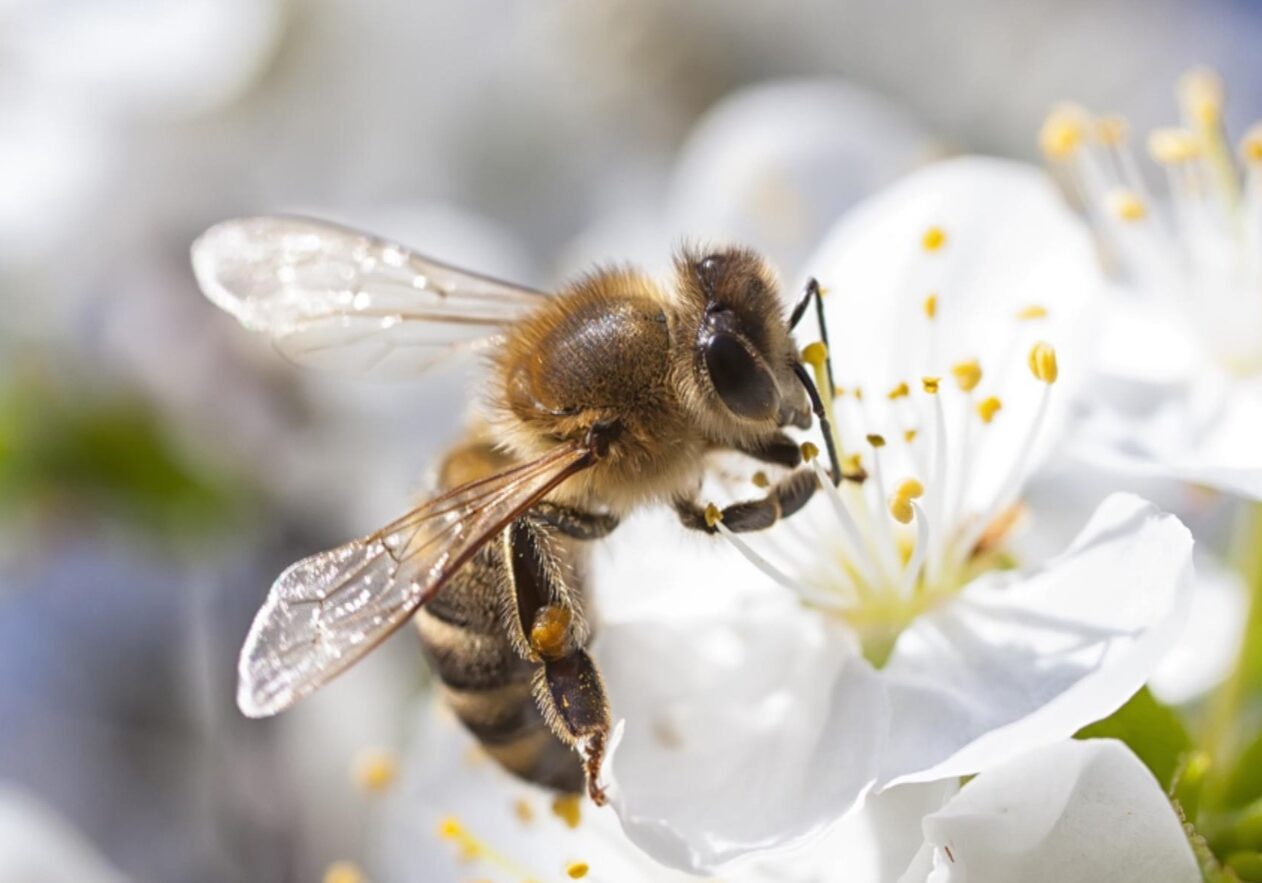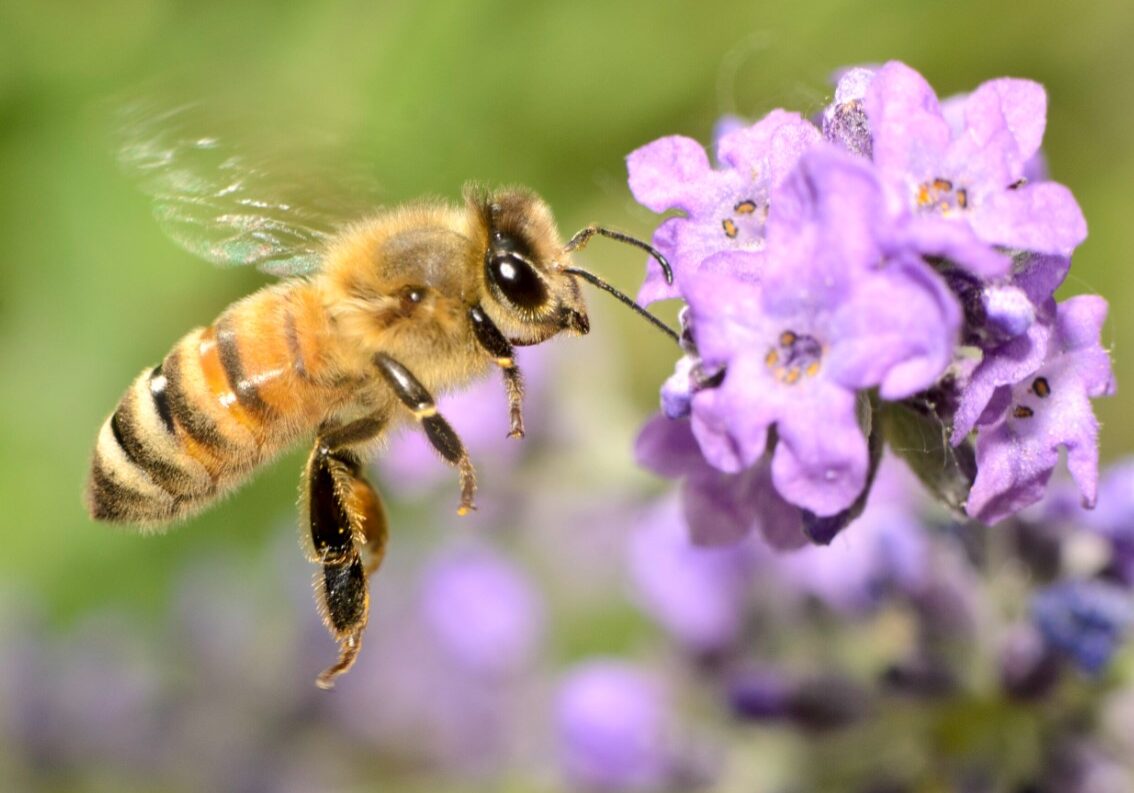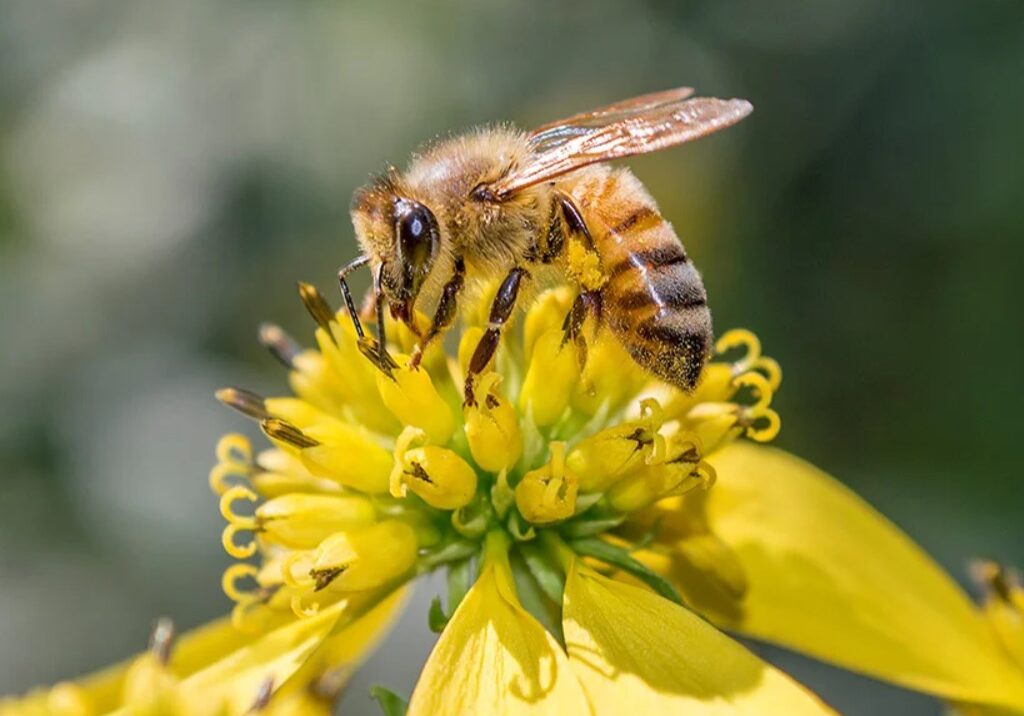
LET'S LEARN MORE ABOUT BEES
Bees are winged insects closely related to wasps and ants, known for their roles in pollination and, in the case of the best-known bee species, the western honey bee, for producing honey. Bees are a monophyletic lineage within the superfamily Apoidea. They are currently considered a clade, called Anthophila. There are over 20,000 known species of bees in seven recognized biological families. Some species – including honey bees, bumblebees, and stingless bees – live socially in colonies while most species (>90%) – including mason bees, carpenter bees, leafcutter bees, and sweat bees – are solitary.
LET'S DISCOVER
tYPES OF BEES
More than 25,000 species of bees have been identified around the world. In the continental United States, there are approximately 3,500 species of bees.
The bees commonly known as honey bees are represented by 10 species in the genus Apis. Apis mellifera, which means honey carrier, is the species of honey bee commonly found today in the Americas. Each species of honey bee has different physical and behavioral characteristics such as body color, wing length and susceptibility to disease.
Honey bees live in colonies and are social insects. A colony can have 20,000-100,000 bees, which depend on one another for survival.
Three types of adult bees make up a honey bee colony.



Worker Bees: Approximately 99% of adult honey bees are sterile female worker bees.
Worker bees are developed from fertilized eggs and are fed royal jelly for three days. For the remainder of their larval stage, they are fed beebread. Worker bees' complete metamorphosis takes 21 days. Then, they will live only 6-8 weeks.
Queen Bee: The mother of the colony is the queen bee. There is only one queen in each colony.
Queen bees develop from fertilized eggs in the largest cells in the hive. A larva destined to become a queen bee is fed royal jelly for its entire larval stage. It only takes 16 days for a queen bee to develop.
The queen's primary job is to lay up to 3,000 eggs per day. She also produces pheromones, chemicals that tell other bees in the hive she is working and inhibit the development of other queens.
The queen is fed and cared for by worker bees and only leaves the hive to mate. After mating, she maintains the sperm collected in a special pouch in her body and can continue laying eggs for up to 2 years.
Drones: Male members of the colony are called drones.
Drones develop from unfertilized eggs laid in larger cells and are fed the same way as the worker bees. Their complete metamorphosis takes 24 days. Drones have wider bodies than workers, rounded abdomens and no stingers.
Drones exist solely to mate with the queen.
Bees feed on nectar and pollen, the former primarily as an energy source and the latter primarily for protein and other nutrients. Most pollen is used as food for their larvae. Vertebrate predators of bees include primates and birds such as bee-eaters; insect predators include beewolves and dragonflies.
Bee pollination is important both ecologically and commercially, and the decline in wild bees has increased the value of pollination by commercially managed hives of honey bees. The analysis of 353 wild bee and hoverfly species across Britain from 1980 to 2013 found the insects have been lost from a quarter of the places they inhabited in 1980.


Human beekeeping or apiculture (meliponiculture for stingless bees) has been practised for millennia, since at least the times of Ancient Egypt and Ancient Greece. Bees have appeared in mythology and folklore, through all phases of art and literature from ancient times to the present day, although primarily focused in the Northern Hemisphere where beekeeping is far more common. In Mesoamerica, the Mayans have practiced large-scale intensive meliponiculture since pre-Columbian times.

In rare cases, a plant species may only be effectively pollinated by a single bee species, and some plants are endangered at least in part because their pollinator is also threatened. But, there is a pronounced tendency for oligolectic bees to be associated with common, widespread plants visited by multiple pollinator species. For example, the creosote bush in the arid parts of the United States southwest is associated with some 40 oligoleges.

Honey, according to a Greek myth, was discovered by a nymph called Melissa ("Bee"); and honey was offered to the Greek gods from Mycenean times. Bees were also associated with the Delphic oracle and the prophetess was sometimes called a bee.
The image of a community of honey bees has been used from ancient to modern times, in Aristotle and Plato; in Virgil and Seneca; in Erasmus and Shakespeare; Tolstoy, and by political and social theorists such as Bernard Mandeville and Karl Marx as a model for human society. In English folklore, bees would be told of important events in the household, in a custom known as "Telling the bees".

The 2007 animated comedy film Bee Movie used Jerry Seinfeld's first script and was his first work for children; he starred as a bee named Barry B. Benson, alongside Renée Zellweger. Critics found its premise awkward and its delivery tame. Dave Goulson's A Sting in the Tale (2014) describes his efforts to save bumblebees in Britain, as well as much about their biology. The playwright Laline Paull's fantasy The Bees (2015) tells the tale of a hive bee named Flora 717 from hatching onwards.

Among Classical Era authors, beekeeping with the use of smoke is described in Aristotle's History of Animals Book 9. The account mentions that bees die after stinging; that workers remove corpses from the hive, and guard it; castes including workers and non-working drones, but "kings" rather than queens; predators including toads and bee-eaters; and the waggle dance, with the "irresistible suggestion" of άροσειονται ("aroseiontai", it waggles) and παρακολουθούσιν ("parakolouthousin", they watch).
Beekeeping is described in detail by Virgil in his Georgics; it is also mentioned in his Aeneid, and in Pliny's Natural History.
From the 18th century, European understanding of the colonies and biology of bees allowed the construction of the moveable comb hive so that honey could be harvested without destroying the colony.


HONEY BEE HIVES
Honey bee hives can be natural or man-made. Wild honey bees usually build their hives in hollow trees or other sheltered places. Beekeepers provide wooden homes for bees.
The worker bees secrete wax from their bodies. They chew this wax and use it to build large sheets called wax combs. Each comb consists of six-sided wax structures called cells. Thousands of cells make up each comb; they are used for storing honey and pollen, and as nurseries for developing bees.
Bees make honey from nectar, a sweet liquid found inside flower blossoms. Worker bees collect nectar and carry it to their colony in pouches within their bodies. The secret ingredient that turns nectar into honey is bee spit. Chemicals in bees’ saliva help change nectar into sugars. This nectar/saliva mixture is stored in the beeswax comb.

THE IMPORTANCE OF POLLINATORS
The results AND
Honeybees are superb pollinators and very important to agriculture. For many plants, the production of seeds that will grow depends on pollination, the transfer of pollen from one flower to another. Most pollination occurs when insects and other creatures brush against the pollen-bearing part of a flower and pick up pollen. When the bee goes to another flower, some of the pollen from the first flower sticks to the second flower.
Pollination must occur for flowering plants to reproduce. Insects are responsible for the majority of pollination. About one-third of the human diet is derived directly or indirectly from insect-pollinated plants, about 80% of which is pollinated by honey bees.
It is estimated that honey bees annually pollinate more than $14 billion worth of seeds and crops. Beekeepers truck tens of billions of bees around the country every year, moving from field to field.
If all honey bees disappeared, it is estimated that about one-third of the foods we eat today would disappear as well. Almond crops are entirely dependent on honey bee pollination. Apples, avocados, blueberries, cherries, cranberries and sunflowers are 90% dependent on honey bee pollination.


Bees population decline
Help the bees!
Over the last half century, there has been a general decline in the species richness of wild bees and other pollinators, probably attributable to stress from increased parasites and disease, the use of pesticides, and a general decrease in the number of wild flowers. Climate change probably exacerbates the problem.[151] This is a major cause of concern, as it can cause biodiversity loss and ecosystem degradation as well as increase climate change.

hOW DO THEY CREATE HONEY?
Honey gets its start as flower nectar, which is collected by bees, naturally broken down into simple sugars and stored in honeycombs. The color and flavor of honey varies from hive to hive based upon the type of flower nectar collected by the bees.
Honey is pure, natural and never spoils. It is primarily composed of the sugars glucose and fructose. It is fat-free and cholesterol-free. One tablespoon of honey is 64 calories. Honey has a healthy glycemic index, meaning that its sugars can be gradually absorbed into the blood stream.
Honey is produced in every American state. According to the LSU AgCenter, Louisiana honey production for 2011 was 1.9 million pounds. The top five honey producing states in 2011 were North Dakota, California, South Dakota, Montana and Florida. Honey production in 2011 was 148 million pounds.
Americans import honey in order to meet our consumers’ demand.
In 2023, Canada produced 91.8 million pounds of honey, a 23.4% increase from the previous year. This made Canada the world's sixth largest producer of honey.
Honey production by region
Alberta
40% of Canada's honey came from Alberta's 302,900 colonies
Saskatchewan
21.8% of Canada's honey came from Saskatchewan
Manitoba
18.8% of Canada's honey came from Manitoba


Medicinal benefits
Apitherapy is a branch of alternative medicine that uses honey bee products, including raw honey, royal jelly, pollen, propolis, beeswax and apitoxin (Bee venom) have been used for centuries in traditional medicine to treat a variety of conditions.
Honey
Treats oral diseases like stomatitis, halitosis, and periodontal disease
Prevents dental plaque, gingivitis, and mouth ulcers
Has antibacterial and anti-inflammatory properties
Bee venom
Used to treat musculoskeletal diseases like arthritis and arthralgia
Used to treat autoimmune diseases like lupus and multiple sclerosis
Used to treat cancer
Has anti-inflammatory, antioxidant, and antibacterial properties
Other bee products
Propolis has been used in traditional medicine for centuries
Royal jelly is a bee product that has been used in traditional medicine
Bee pollen is a bee product that has been used in traditional medicine
Bee bread is a bee product that has been used in traditional medicine
Beeswax is a bee product that has been used in traditional medicine
Research suggests that bee products may also help with Alzheimer's, Lyme disease, and antibiotic-resistant infections.






